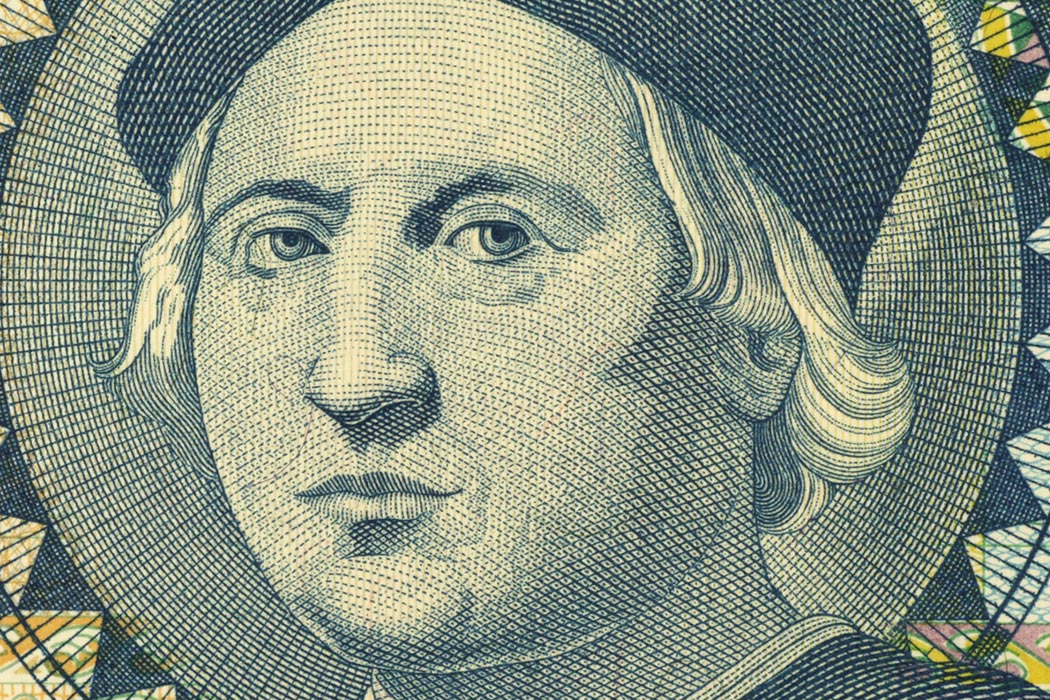Last year, Seattle’s city council unanimously voted to celebrate Indigenous Peoples’ Day in place of Columbus Day. Minneapolis also adopted this holiday earlier in the year to honor the history of indigenous American citizens over the legendary and mythic figure of Columbus. Both cities were new additions to a growing handful of states that have been refusing to observe Columbus Day as a national holiday.
Let’s revisit Christopher Columbus through a variety of lenses, examining the myths and legends behind this once exalted and now oft-contested figure.
Weekly Newsletter
In “The Legend of Christopher Columbus,” Grace Marmor Spruch scientifically approaches a Columbus myth that many of us learned in school: that with his voyage, Columbus was debunking a largely-held belief that the world was flat. In her article, Spruch applies her background in physics (and the history of physics) to the Columbus story, tracking the ancient Greeks like Eratosthenes and Aristotle who had previously discovered that the world was round. If they knew and had proved this, she wondered, why had the flat-world-Columbus-story become so popular?
Through her research, Spruch studied Washington Irving’s 1828 biography Life and Voyages of Christopher Columbus, which was the first to perpetuate the myth. Furthermore, Spruch was able to uncover just how popular and far-reaching his biography was: in just thirty years, the book was “reprinted thirty-nine times in English and fifty-one other languages.”
In examining Irving’s reach, Spruch confronted the construction of history itself:
The way ‘history’ alters with time is rather shocking to the non-historians. We tend to assume, as we do in everyday affairs, that the present state of things has been ever thus. What is standard for professionals can be an epiphany for the uninitiated.
She continues, “[Lilian] Handlin showed that Columbus had been ‘an irrelevancy’ in this country before 1750, and that his voyage was celebrated sparsely, and only among select groups, when its three hundredth anniversary arrived in 1792. But nineteenth-century Americans recognized in Columbus the spirit of the frontier.” And it was shortly after this that Irving published his book and set the dominant image of Columbus for the next century.
In “Colonial Discourse Since Christopher Columbus,” Asselin Charles discusses the ideology and discursive narrative that Columbus brought with him, analyzing the power of language and its imperative role in the colonial process. Charles wrote this article in 1995, just after the fall of apartheid in South Africa, opening with a wary and cautionary message, “[l]et us not hurry and rejoice…” He continues:
If the classic colonialism baptized at the Berlin Conference in 1884 is on its death bed, if its institutions, laws, and rituals are soon to be history, both the worldview underlying it and the verbal expression of its ideology, colonialist discourse, will linger much longer in the hearts and minds of both former colonizers and former colonial subjects.
Charles argues that while superior technology and organization are often acknowledged as the West’s upper hand in its colonial endeavors, more thorough studies of the “expression of its ideology” has been neglected. “Colonialist discourse, the verbal expressions of the West’s will and right to power, has turned out to be one of the most effective weapons of conquest and dominance.”
In rethinking discursive ideological power, Charles analyzes how Columbus’ endeavor played into the larger building of European empire. “The world found by Columbus would be forced into the emerging paradigm in a discourse that was partly religious and partly economic, incorporating into its lexicon the myths, obsessions, dreams, and nightmares of Europe.” In other words, what Columbus saw and then imparted on the Western world was much more a product of Europe than it was of the “new world,” which was, of course, not new.
Much like Charles’ alternate analysis of Columbus, Howard Schuman et al. analyze history and survey results about the changing views of Christopher Columbus over the years. In this study, they aim to raise “important questions about the inertia of tradition, the politics of collective memory, and the difference between elite and popular beliefs” as they study collective- and counter-memories of this contested figure.
As with Spruch’s history, Schuman et al. trace the roots of changing and growing Columbus myths to the commemoration celebrations, such as the significant 300th anniversary in 1792 when E. de Lancey noted that America’s “discovery” was termed “the greatest event in the history of mankind since the death of our Savior.” This 300th anniversary marked the making of the Columbus Day celebrations that carried us well into the late 1900s; however, Schuman et al. note that it was 1992’s 500th anniversary that marked the beginning of reform movements to revise, critique, and protest Columbus’ once laudatory image.
They cite James Axtell who observed, “[t]he most striking difference between the fourth and fifth Columbian centenaries…[was] that native Americans a century ago were relegated to the footnotes while today they not only dominate the text but have begun to rewrite it.”
The relatively recent transformation from Columbus Day celebrations to Indigenous Peoples’ Day celebrations reflects this changing tide. At this time last year, the Seattle Times quoted Kshama Sawant, a Seattle City Council member, who explained the stakes involved in revising this holiday:
This is about taking a stand against racism and discrimination…Learning about the history of Columbus and transforming this day into a celebration of indigenous people and a celebration of social justice…allows us to make a connection between this painful history and the ongoing marginalization, discrimination and poverty that indigenous communities face to this day.
One can only imagine what the 600th anniversary celebration might look like in 2092, but given the shifting historiography of the man, myths, legends, collective memories, and counter memories, Columbus Day celebrations might have finally met their demise.







